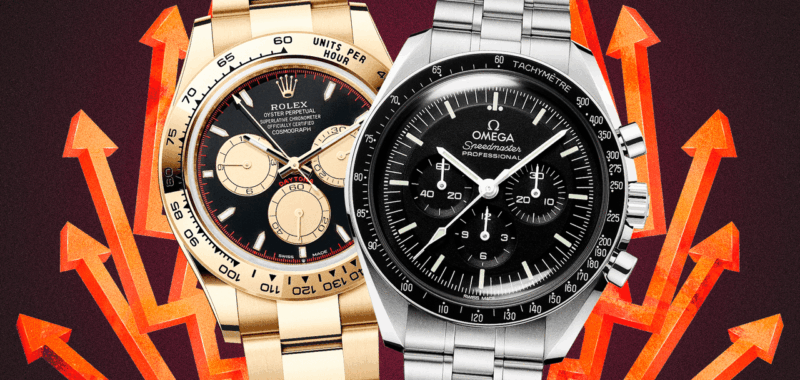When President Trump first announced the sky-high 31% tariffs on Switzerland, where a vast majority of the world’s luxury timepieces are made, it prompted immediate defensive maneuvering in the watch world. One vintage dealer’s foreign supplier took an emergency flight with a huge cache of watches, while modern retailers stocked up on inventory, fearing new challenges in sourcing pieces. The panic quieted when the Trump administration put a 90-day pause on the most punitive tariffs but we’ve learned that brands are still responding to the remaining 10% tax. The bottom line is that the most desirable watches in the world are about to get pricier.
Rolex was one of the first dominoes to drop, as Hodinkee first reported. Beginning May 1, the Crown will increase its prices by roughly 3%. According to that same report, Omega was set to follow with a 5% increase on average for the pieces in its catalog. Meanwhile, rumors are swirling among industry insiders that other marques will soon be following suit. While specific figures aren’t forthcoming, certain Richemont and Swatch Group companies, like Cartier, as well as independents such as Breitling, are among those who will increase the manufacturer’s suggested retail price, or MSRP, in the US. (LVMH brands—which include the likes of TAG Heuer and Bvlgari—will almost certainly do the same.) Expect a 3% to 5% increase for these brands. Industry sources also confirmed that retailers’ margin will decrease in certain cases, hurting the authorized dealers who sell watches.
Even Trump’s considerably smaller 10% levy is set to have a significant impact on the market, causing the aforementioned price hikes that may impact appetite for new watches among all but the most well-heeled clients. In addition to dampening demand for many luxury watches, it will almost certainly drive customers to the secondary market—a potential boon to resellers. “This isn’t just a policy shift—it’s a realignment of how collectors will access fine timepieces in the US,” said Joshua Ganjei of Boston’s European Watch Company. “Tariffs will put a lot of pressure on brands and authorized dealers while creating tremendous opportunities for the secondary market. If MSRP were to rise considerably, collectors would look for local, pre-owned alternatives to enjoy the hobby.”
Still, certain brands—particularly high-end independents whose clientele are less subject to market volatility and tariffs—aren’t setting their hair aflame just yet. Edouard Meylan, CEO of H. Moser & Cie, was certainly surprised by the initial 31% tariff. “That said, we remain serene,” he said. “Our relationships with US retail partners are built on trust, long-term vision, and mutual respect. The majority of orders for the year to come were placed well ahead of this announcement, and based on our initial conversations, we do not expect any cancellations. Many of our partners remain confident that this situation will evolve and potentially be resolved in time.”
Meylan did note that as soon as the initial 31% tariff was announced, his brand proactively shipped product before it could take effect. Thankfully, of course, Trump backtracked somewhat, but the 10% tariff that remains in effect will certainly translate to some sticker shock at your local authorized dealer.
Watches are, of course, luxury items—none of us needs a little mechanical timekeeper strapped to our wrist anymore. But the reverberations of Trump’s trade policy will certainly make themselves felt not only by American consumers but, depending upon what it does to dampen demand, on the watchmakers (and retailers) themselves. For now, if you’re looking to snag the latest Sub, Speedmaster, or Tank, expect to save up a few more Benjamins to do so.

